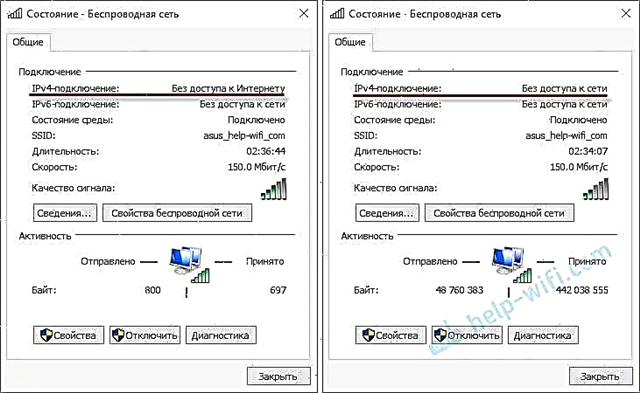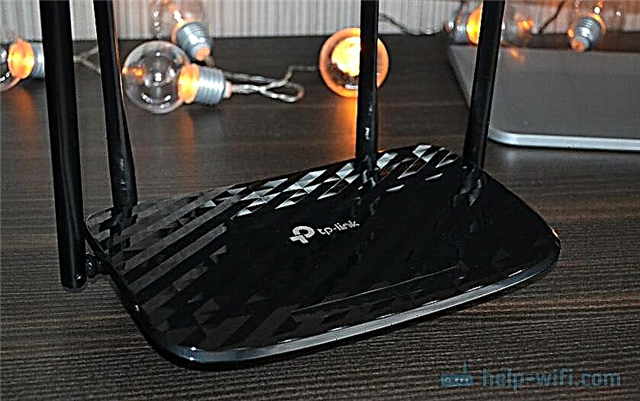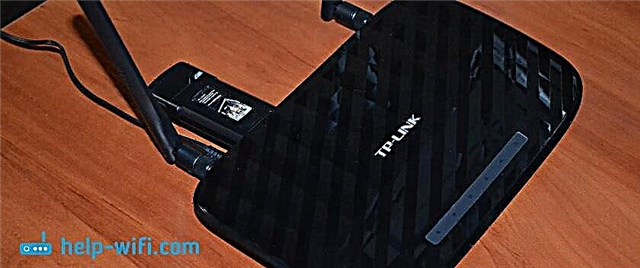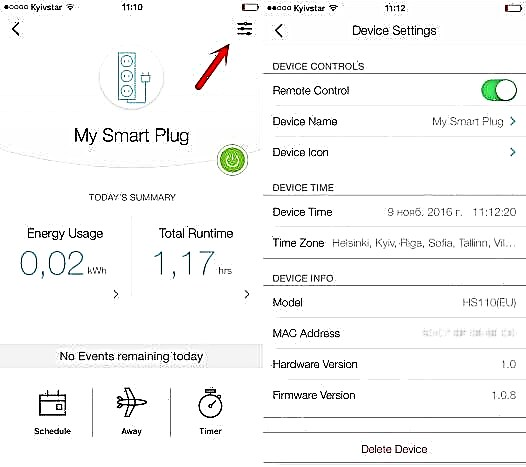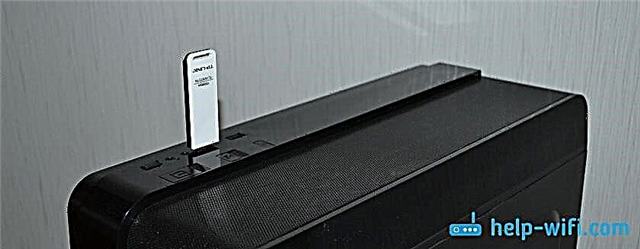If you have a regular desktop computer, and the Internet is connected via a Wi-Fi router, then there are at least two ways that you can connect a PC to a router.
Let's look at both options:
- With a network cable. In this case, there is one big minus and one big plus. The downside is that you need to lay a network cable from the router to the computer. And if the router is installed near the PC, then this is not a problem. But it is not always possible to stretch the cable. It is not always convenient and beautiful. Well, the plus is that the cable connection is more stable, and the Internet speed will be higher.
- Via Wi-Fi network, using a special adapter. In stationary computers, as a rule, there are no built-in Wi-Fi adapters, and in order to connect a PC to a wireless network, this adapter must be purchased, installed and configured. This is not a problem, but an additional cost. But no wires. I wrote about this in the article: how to connect a regular computer (PC) to a Wi-Fi network.
In this article, we will take a closer look at what Wi-Fi adapters for a PC are, what to look for when choosing, and how to choose the right adapter for a stationary computer. It should be noted that the USB adapters that will be discussed in this article can also be used on laptops without any problems. If the built-in module is broken or does not work for some other reason.
Perhaps you have another router, then you can try to configure it as a receiver according to this instruction.
What are Wi-Fi adapters? Determining the connection interface
First of all, I advise you to decide on the interface through which the adapter will be connected to the stationary computer. The most popular are USB and PCI Express. There is also PCMCIA (mainly for laptops), but they are no longer very relevant, therefore, we will not consider them. Let's take a closer look at receivers that connect via USB and PCI.
- Interface: USB... They are also called external. The most popular Wi-Fi adapters that look like a regular USB flash drive. They are different. Very small (like a receiver for a wireless mouse or keyboard), about the size of a USB flash drive, or more serious options that are connected via a USB extension cable. Such receivers can be with or without antennas. They look something like this:
 These receivers plug into your computer's USB port. For better reception (to lift the adapter higher), you can connect it via a USB extension cable. Extension cords are included with some models. They can be used on a variety of computers and laptops. Quickly disconnect and reconnect. If you choose a receiver specifically for a regular computer, and not a laptop, then it is better to take a model with an antenna, or one that connects through an extension cable. For better Wi-Fi network reception. The miniature model (the first in the picture above) is best suited for laptops.
These receivers plug into your computer's USB port. For better reception (to lift the adapter higher), you can connect it via a USB extension cable. Extension cords are included with some models. They can be used on a variety of computers and laptops. Quickly disconnect and reconnect. If you choose a receiver specifically for a regular computer, and not a laptop, then it is better to take a model with an antenna, or one that connects through an extension cable. For better Wi-Fi network reception. The miniature model (the first in the picture above) is best suited for laptops. - Interface: PCI Express... These are internal receivers. They look like a regular network card and plug into a PCI Express port on your computer's motherboard.
 To install such an adapter, your computer must have a free PCI Express (PCI Express x1) slot. You will also need to hide the system unit. Well, as you understand, it will not work to quickly disconnect and connect such a receiver to another PC. Just like lifting it up on an extension cord for better reception. Although they shouldn't have any problems with reception, all models have good antennas to amplify it. Pros: does not occupy a USB port and does not stick out of the system unit (only antennas). Which, by the way, can be replaced with more powerful ones, or remote ones.
To install such an adapter, your computer must have a free PCI Express (PCI Express x1) slot. You will also need to hide the system unit. Well, as you understand, it will not work to quickly disconnect and connect such a receiver to another PC. Just like lifting it up on an extension cord for better reception. Although they shouldn't have any problems with reception, all models have good antennas to amplify it. Pros: does not occupy a USB port and does not stick out of the system unit (only antennas). Which, by the way, can be replaced with more powerful ones, or remote ones.
I think you've decided on the connection interface. As for other characteristics, there are no differences between USB and PCI. The information below applies to Wi-Fi adapters with different interfaces.
Choosing a Wi-Fi receiver by technical characteristics
After you have decided on the connection interface, you need to look at other specifications. Basically, it's one metric: wireless Wi-Fi data transfer rate. This determines the speed of the Internet connection that you get on your computer when connected via a Wi-Fi receiver.
Also pay attention to the gain of the Wi-Fi network. I looked at different adapters, the characteristics usually do not indicate the power of the antennas. If your computer is installed far from the router, where the signal is not very stable, then take a receiver with external antennas for good Wi-Fi signal reception. The system unit is usually installed on the floor. Therefore, for better reception, the adapter can be connected via a USB extension cable (if you have an external model) and put it on the table.
Wi-Fi standard, support 802.11ac (5 GHz)
At the time of this writing (end of March 2017), the largest number of adapters supporting the 802.11n standard are on sale. Wireless network speed up to 300Mbps (may be higher). The cheapest Wi-Fi adapters provide speeds up to 150 Mbps. I would recommend buying such adapters only when you need to save a lot. Better, of course, to buy a receiver with a speed of up to 300 Mbps, and even better with support for the modern 802.11ac standard.
If you have a dual-band router installed, or you are planning to purchase such a router for the transition to the new 802.11ac standard, then of course immediately buy an adapter with 802.11ac support, and the ability to connect to Wi-Fi networks at a frequency of 5 GHz. In 2017, this is very relevant. So that after replacing your router with a more modern one, you don't have to buy a new 802.11ac receiver.
Let me explain now. If you have (or already have) a modern router that supports the new 802.11ac standard, and an adapter that supports 802.11n, then you can connect to a Wi-Fi network, they are compatible. But the speed will be limited by the slower 802.11n standard. And you will not see the full potential of a router with support for the 802.11ac standard, since the receiver will limit the speed.
Adapter, PC and router compatibility
I have already been asked several times whether it is necessary to select a Wi-Fi adapter for a specific router and computer. I answer: it is not necessary. Everything will work. There are, of course, exceptions, usually associated with very old equipment. But I think that you will not face it.
If your computer has a working USB port, then you can plug the adapter into it. It's the same with PCI Express. As far as compatibility with the installed operating system is concerned, almost all adapters support operating systems from Windows XP to Windows 10. This means that the manufacturer has released drivers for these systems. This is always indicated in the specifications for a particular model. Almost all models also support Mac OS.
As for the compatibility of the adapter and the router, it is also difficult to miss there. Almost impossible. Since the Wi-Fi standards are compatible with each other. And I very much doubt that you will find somewhere so ancient a router that the new receiver is incompatible with it. The adapter itself not necessary should be about the same manufacturer as the router.
Manufacturer, price, which model to choose?
Almost every manufacturer that makes network equipment also manufactures Wi-Fi adapters. TP-Link, ASUS, D-Link, Netis, Tenda, Edimax, Belkin, Linksys, etc. The choice is very large. Which manufacturer to choose is up to you. I would advise you to focus not on the company, but on the technical characteristics (which suit you) and the price.
As for the price, it starts at about $ 6. For this amount we will get the simplest, smallest receiver with support for speeds up to 150 Mbps. Now I will introduce exactly the models from popular manufacturers. No Chinese devices. Again, focus on your budget. If possible, of course it is better to take a more expensive, modern and productive model.
Popular adapters include TP-LINK TL-WN725N, D-Link DWA-131, Tenda W311MA, Asus PCE-N15, Asus USB-N14, TP-LINK TL-WN727N, TP-LINK TL-WN722N, Tenda W311M and others. Look in online stores. Read reviews. The choice is actually very large. Once you've found a model that's right for you, you can go out and buy it at a regular store. Or order online.
If you've read my article with tips on choosing a Wi-Fi router, you probably noticed that I don't really like to recommend specific models. And that doesn't make sense either. Since everyone has different requirements and financial capabilities.
How to connect and configure?
I showed the setup process using the TP-Link Archer T4UH adapter as an example. Some points may differ depending on the manufacturer and model. But as a rule, all actions are very similar.
First you need to connect the adapter to your computer. Into USB port, or install it into PCI Express.

Next, you need to install the driver and utility. The utility to manage the adapter itself does not need to be installed. Sometimes it is automatically installed with the driver. If the kit did not include a driver disc, or you cannot install from a disc, you can download it from the Internet. Only download from the manufacturer's official website and strictly for your adapter model. On the website of each manufacturer there is such an opportunity.
After installing the drivers, you can connect your computer to a Wi-Fi network through the standard Windows menu, or using a proprietary utility. The process itself is no different from what I described in the article: how to connect a laptop (computer) to the Internet via Wi-Fi.
Also, by connecting the Internet to the computer via a network cable, and installing a Wi-Fi adapter, you can not receive, but distribute Wi-Fi. How to do this, I wrote in the article: how to distribute the Internet via a Wi-Fi adapter on a PC.
If your PC was previously connected to the Internet via cable, then after connecting via Wi-Fi, the connection speed may drop significantly. This is okay, and it does not mean that you did something wrong, or that you configured something wrong. True, it all depends on how much the speed has dropped. You can find tips on how to increase the speed of your Wi-Fi connection in this article.
In the comments, you can leave your question, or share useful information on this topic!

 These receivers plug into your computer's USB port. For better reception (to lift the adapter higher), you can connect it via a USB extension cable. Extension cords are included with some models. They can be used on a variety of computers and laptops. Quickly disconnect and reconnect. If you choose a receiver specifically for a regular computer, and not a laptop, then it is better to take a model with an antenna, or one that connects through an extension cable. For better Wi-Fi network reception. The miniature model (the first in the picture above) is best suited for laptops.
These receivers plug into your computer's USB port. For better reception (to lift the adapter higher), you can connect it via a USB extension cable. Extension cords are included with some models. They can be used on a variety of computers and laptops. Quickly disconnect and reconnect. If you choose a receiver specifically for a regular computer, and not a laptop, then it is better to take a model with an antenna, or one that connects through an extension cable. For better Wi-Fi network reception. The miniature model (the first in the picture above) is best suited for laptops. To install such an adapter, your computer must have a free PCI Express (PCI Express x1) slot. You will also need to hide the system unit. Well, as you understand, it will not work to quickly disconnect and connect such a receiver to another PC. Just like lifting it up on an extension cord for better reception. Although they shouldn't have any problems with reception, all models have good antennas to amplify it. Pros: does not occupy a USB port and does not stick out of the system unit (only antennas). Which, by the way, can be replaced with more powerful ones, or remote ones.
To install such an adapter, your computer must have a free PCI Express (PCI Express x1) slot. You will also need to hide the system unit. Well, as you understand, it will not work to quickly disconnect and connect such a receiver to another PC. Just like lifting it up on an extension cord for better reception. Although they shouldn't have any problems with reception, all models have good antennas to amplify it. Pros: does not occupy a USB port and does not stick out of the system unit (only antennas). Which, by the way, can be replaced with more powerful ones, or remote ones.